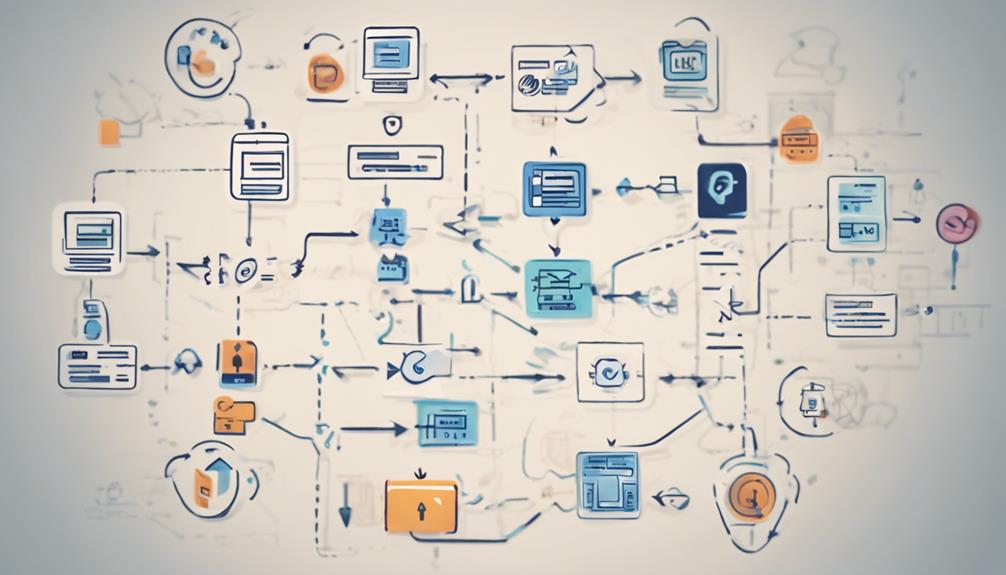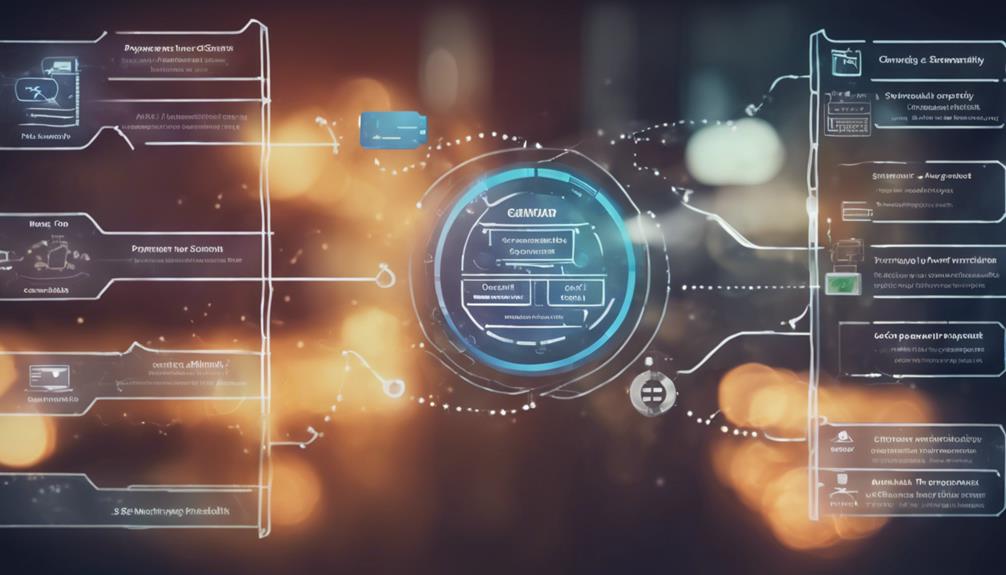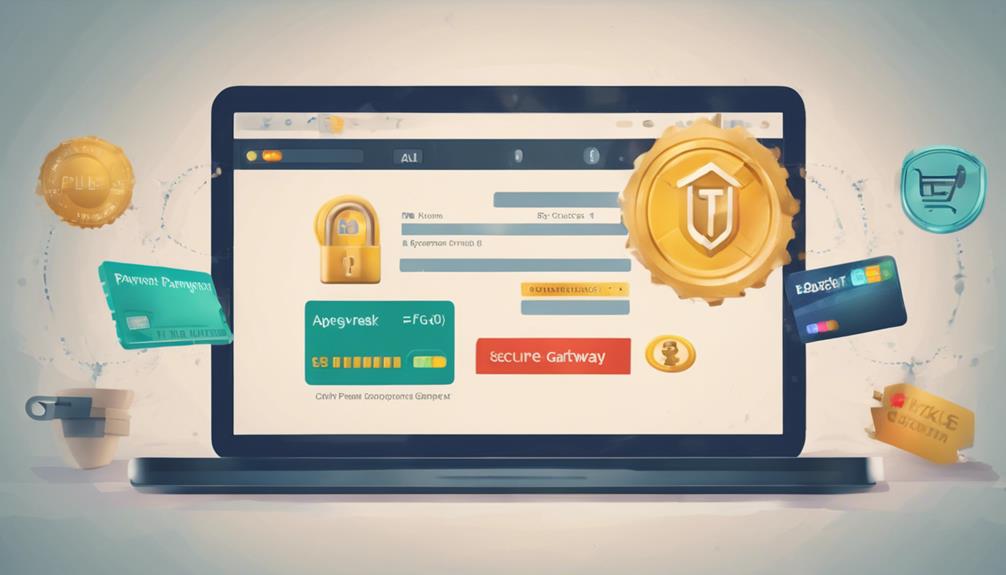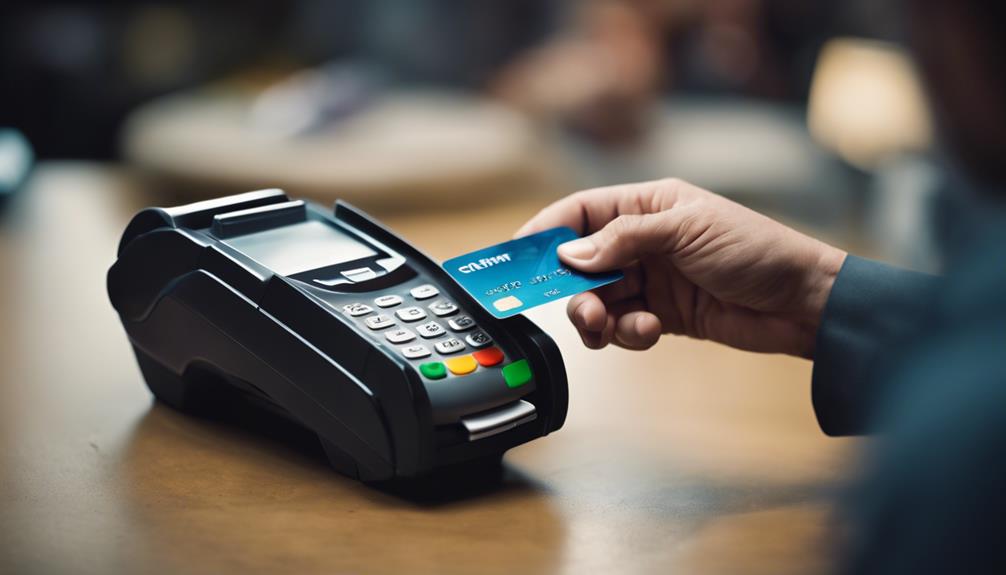Before setting up your payment gateway, grasp key elements for smooth transactions. Understand different gateway types for direct or redirected processing. Learn about encryption, authorization, and fund settlement features to guarantee secure operations. Consider platform compatibility, security standards, and transaction costs. Prioritize encryption and fraud prevention for data safety, adhering to PCI DSS standards. Verify hosting support and thoroughly test integration. Familiarize with your chosen provider's setup process for efficient transactions. Address common challenges like integration complexity and transaction fees. Following best practices guarantees a secure and seamless payment gateway setup tailored to your business needs.
Key Takeaways
- Confirm compatibility with website platform
- Assess security measures and PCI DSS compliance
- Review transaction fees and pricing structure
- Ensure customer support availability
- Evaluate options for seamless transaction processing
Types of Payment Gateways

When selecting a payment gateway, consider the types available to determine the best fit for your business needs. Payment gateways come in three main categories: self-hosted, hosted, and non-hosted. Self-hosted gateways allow you to process transactions directly on your website, providing a seamless checkout experience for your customers.
Hosted gateways, on the other hand, redirect customers to a secure payment page during the checkout process, which can be beneficial for businesses looking to outsource payment security. Non-hosted gateways enable you to collect payment information directly on your website, giving you more control over the payment process.
Each type of gateway offers different integration options, security measures, customization features, and compliance standards. Understanding these differences is vital in selecting a payment gateway that aligns with your business's specific requirements. Self-hosted gateways may offer more customization options, while hosted gateways often provide enhanced security measures. Non-hosted gateways give you direct control over the payment process on your website.
Consider your business's needs for security, customization, and compliance when choosing the right type of payment gateway.
Understanding Payment Gateway Functionality

When it comes to payment gateways, understanding their functionality is key.
These gateways play a crucial role in facilitating secure transactions between parties.
Role in Transactions
Payment gateways play a pivotal role in facilitating secure and efficient transactions by encrypting payment information and coordinating authorization requests with card networks and acquiring banks. When a customer makes a purchase, the payment gateway securely transmits the credit card details to the acquiring bank for authorization. This process guarantees that the funds are available and initiates the transfer from the customer's account to the business's account upon approval. Here is a breakdown of the payment gateway's role in transactions:
| Payment Gateway Role | Description |
|---|---|
| Encryption | Encrypts payment information for secure transfer |
| Authorization | Coordinates with card networks for approval |
| Settlement | Settles funds with acquiring bank into business account |
| Transaction Process | Manages collection, verification, and completion |
Understanding these functions is essential for businesses to enable seamless payment processing.
Data Security Measures
To enhance the security of online transactions, payment gateways implement robust data encryption measures to safeguard sensitive payment information during transmission. Encryption plays an essential role in guaranteeing that payment gateway securely transmits data, protecting it from unauthorized access.
These gateways also handle authorization requests, seeking transaction approval from card networks. Additionally, they play an important role in settling funds by transferring approved amounts from acquiring banks to the merchant's account.
Factors to Consider Before Implementation

Before proceeding with the implementation of a payment gateway, it's important to carefully evaluate several key factors.
To start with, consider the compatibility of the payment gateway with your website platform and existing systems to guarantee smooth integration.
Next, assess the security standards provided by the gateway to safeguard card data and protect sensitive information during online payments.
Additionally, review the transaction fees and pricing structure to make sure of cost-effectiveness for your business.
It's essential to check for the availability of customer support and technical assistance from the payment gateway provider to address any issues promptly.
Additionally, evaluate the options for transaction processing, including integration with popular payment methods and currencies, to cater to diverse customer needs effectively.
Security Measures for Payment Gateways

When setting up your payment gateway, it's essential to prioritize data encryption to safeguard sensitive payment information. Implementing fraud prevention strategies and ensuring compliance with security standards like PCI DSS are key aspects of maintaining a secure payment environment.
Data Encryption Importance
Implementing strong data encryption is essential for payment gateways to ensure the security of sensitive payment information during transmission. When it comes to securing payment data, encryption plays a significant role.
Here are some key points to keep in mind:
- Secure Socket Layer (SSL) and Transport Layer Security (TLS) encryption protocols are commonly used.
- Encryption algorithms like the Advanced Encryption Standard (AES) help convert data into a coded format.
- Compliance with Payment Card Industry Data Security Standard (PCI DSS) requires robust encryption measures.
- Encryption helps in preventing unauthorized access and safeguarding customer data from potential breaches.
Fraud Prevention Strategies
To enhance the security of your payment gateway, consider implementing robust fraud prevention strategies. Start by using multi-factor authentication to verify user identity and prevent unauthorized access.
Utilize tokenization to replace sensitive card data with unique tokens, ensuring secure transactions. Implement real-time monitoring to detect suspicious activities promptly and prevent fraudulent transactions.
Incorporate address verification systems (AVS) to match billing details with cardholder information for added security layers. It's important to regularly update security measures and comply with industry standards like PCI DSS to safeguard against fraud and data breaches effectively.
Compliance With Standards
To strengthen the security of your payment gateway, ensuring compliance with industry standards is vital. Here are some key security measures to contemplate for maintaining compliance:
- PCI DSS Standards: Adhering to PCI DSS standards is essential for secure handling of payment data.
- 3-D Secure Protocol: Implementing this protocol adds an extra layer of security to online transactions.
- Encryption and Tokenization: Utilize encryption and tokenization methods to safeguard sensitive customer information.
- Secure Transmission Protocols: Employ secure transmission protocols to protect data during transactions.
Regular security audits and vulnerability assessments are crucial to guarantee ongoing compliance with these standards and regulations, reducing the risk of data breaches and other security threats.
Integration Requirements for Payment Gateways

Make sure that your website or platform accommodates the integration requirements of the selected payment gateway. Check if there are specific programming languages or frameworks necessary for seamless integration.
Understanding the API documentation provided by the payment gateway is vital for successful integration. Verify if your hosting provider supports the required security protocols for payment gateway integration.
It's essential to thoroughly test the integration to guarantee proper functionality before enabling customer transactions. By adhering to these integration requirements, you can set up a secure and efficient payment gateway on your website.
Pay attention to details such as encryption protocols, data handling, and communication methods to safeguard customer information during transactions. Prioritize a smooth integration process to provide a seamless payment experience for your users, enhancing trust and reliability in your platform's payment capabilities.
Compatibility Checks for Payment Gateways

Confirm that your website or platform is compatible with the selected payment gateway by verifying its integration with your chosen eCommerce platform and preferred payment methods. Before finalizing your payment gateway choice, make sure it meets the necessary criteria:
- Check the compatibility with your website platform: Make sure the payment gateway integrates smoothly with platforms like Shopify, WooCommerce, or Magento.
- Support for currencies and payment methods: Verify that the payment gateway supports the currencies and payment methods you intend to offer to your customers.
- Integration with accounting software: Confirm if the payment gateway seamlessly integrates with your accounting software for efficient financial management.
- Security and compliance standards: Check the level of security and compliance standards the payment gateway follows, such as PCI DSS compliance.
Payment Gateway Setup Process Overview

Start by accessing the Payment Gateway Configuration section under Global Administration in Settings to begin the setup process for your selected gateway. Setting up a payment gateway involves configuring an account with your chosen provider, such as MySchoolBucks, PayPal, or Stripe. This process allows you to securely accept online payments from customers using credit cards. Each payment gateway has specific requirements, so it's crucial to follow the steps provided by the provider. Make sure to input accurate Client IDs and complete any necessary authorizations to guarantee a smooth setup process. By setting up a payment gateway, you enable your school to efficiently handle online transactions and securely process customer data.
| Key Steps for Payment Gateway Setup |
|---|
| 1. Access Payment Gateway Configuration |
| 2. Configure Account with Provider |
| 3. Input Client IDs and Authorizations |
Common Payment Gateway Challenges

Steering through the setup process for your selected payment gateway, you may encounter various challenges that require careful consideration and proactive solutions. Some common payment gateway challenges include:
- Integration Complexity: Connecting the payment gateway with your existing systems and websites can be more intricate than anticipated, requiring technical expertise and troubleshooting.
- PCI Compliance and Data Security: Ensuring that your payment gateway setup is PCI compliant and prioritizes data security is vital but can pose a notable challenge due to the intricacies involved.
- Transaction Fees: Managing transaction fees and understanding the various pricing structures offered by payment gateways can be confusing for new users, impacting the overall cost-effectiveness of the solution.
- Downtime and Technical Support: Dealing with issues such as payment gateway downtime and the responsiveness of technical support can significantly impact the reliability and usability of the service. Addressing these challenges promptly is essential to maintain smooth payment processing operations.
Best Practices for Payment Gateway Setup

For optimal payment gateway setup, prioritize selecting a provider that aligns with PCI DSS standards to guarantee secure payment transactions. Confirm that your payment gateway supports multiple payment methods to accommodate various customer preferences.
When setting up your payment gateway, consider the associated transaction fees and any monthly charges involved. Before going live, thoroughly test the payment gateway to ensure seamless integration with your website or POS system.
It's essential to choose a provider that offers robust customer support to address any issues promptly and effectively. By following these best practices, you can establish a reliable payment gateway that meets your business needs and provides a smooth payment experience for your customers.
Prioritizing security, flexibility, cost-effectiveness, and strong customer support will set the foundation for a successful payment gateway setup.
Frequently Asked Questions
What Are the Requirements for Payment Gateway?
To set up a payment gateway, you need a merchant account and must comply with PCI DSS regulations. Integration with your platform is necessary for smooth transactions.
Different gateways have specific setup requirements, like documentation and verification. Knowing the fees and transaction costs upfront is essential.
Make sure you meet these requirements for a successful payment gateway setup.
What Do You Need to Know About Payment Gateway?
To understand payment gateways, you should know they secure and process customer payments. These gateways encrypt sensitive data for safe transmission. They function both online and in physical stores, ensuring smooth transactions.
Involved parties include customers, banks, merchants, and processors. Various gateways cater to different integration needs and security standards. Familiarize yourself with these fundamentals to navigate the world of payment gateways effectively.
How to Start a Payment Gateway?
To start a payment gateway, sign up with a provider that suits your needs. Follow their setup instructions, integrating the gateway with your website or platform.
Test transactions to guarantee everything works smoothly. Keep your payment gateway secure and updated to protect customer data.
Provide clear payment options for your users. Regularly review fees and features to optimize your payment processing.
What Is Needed to Integrate Payment Gateway?
To integrate a payment gateway, you'll need:
- A merchant account
- An SSL certificate for secure data transmission
- Compliance with PCI DSS requirements
- A suitable provider aligned with your business
- Compatibility with your website platform
These components guarantee seamless integration and secure transactions for your online business.
Be diligent in selecting the right elements to streamline the payment process and safeguard customer information.
Conclusion
Now that you have a better understanding of payment gateway setup, you're equipped to navigate the process with confidence. Remember to take into account factors like security, compatibility, and integration requirements to guarantee a smooth implementation.
By following best practices and staying informed about common challenges, you can set up your payment gateway effectively and efficiently. With these tools in hand, you're ready to take the next step towards seamless online transactions.











